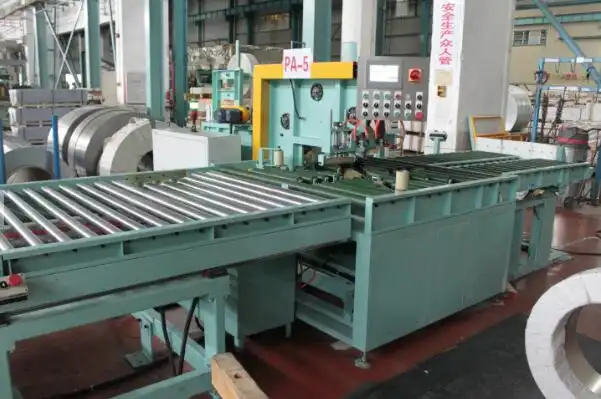Optimizing Packaging for Pancake Copper Coils: A Guide to Automated Shrink Wrapping Lines
Pancake copper coils, also known as level wound coils (LWC), require specific packaging methods to protect them from damage, corrosion, and contamination during handling, storage, and transportation. Automated packaging lines utilizing shrink wrapping technology offer an efficient and reliable solution for manufacturers. This guide details the components, processes, and considerations involved in effectively packaging pancake copper tubes.
Understanding the Need for Specialized Packaging
Pancake copper coils are susceptible to:
- Physical Damage: Dents, scratches, or deformation can occur during handling.
- Corrosion: Exposure to moisture and certain atmospheric elements can tarnish or corrode the copper surface.
- Contamination: Dust and debris can accumulate, potentially affecting downstream processes.
Proper packaging using materials like polyethylene (PE) shrink film creates a protective barrier against these factors, ensuring the coil arrives at its destination in optimal condition.
Components of a Complete Hot Shrinkage Packaging Line
A typical automated packaging line for pancake copper coils integrates several key stages to move from an unpackaged coil to a securely wrapped product ready for shipment.
1. Infeed Conveyor System
- Function: Transports individual pancake coils into the packaging line.
- Types: Often starts with non-powered roller conveyors (Drawing A/E/F/G in some system layouts) for staging, transitioning to powered roller conveyors for controlled movement through the automated sections.
2. Auto Sleeve Wrapping Machine
- Function: Encases the pancake coil in a sleeve of PE shrink film. The machine automatically measures the coil, dispenses the correct amount of film, and seals it around the product.
- Key Feature: Precise film tensioning is crucial to avoid damaging the coil while ensuring a secure wrap.
3. PE Film Shrink Tunnel
- Function: Applies controlled heat to the PE film sleeve, causing it to shrink tightly around the contours of the pancake coil.
- Critical Parameters: Uniform heat distribution and precise temperature control are essential to achieve a consistent shrink without overheating the copper or melting the film. Conveyor speed through the tunnel also dictates exposure time.
4. Outfeed and Cooling Conveyor
- Function: Moves the freshly wrapped coil out of the shrink tunnel. Often incorporates a cooling zone (using ambient air or fans) to allow the film to set properly, ensuring a tight and durable package. Power rollers (as mentioned in some system descriptions) maintain controlled movement.
5. Full Automatic Strapping Machine (Optional/Integrated)
- Function: Applies plastic (PP or PET) straps around the shrink-wrapped coil for additional security, handling ease, or bundling multiple coils.
- Consideration: Strap tension must be carefully controlled to prevent damage to the coil edges.
6. Handling and Offloading Systems
- Function: Assists in moving the packaged coils off the line for palletizing or further handling.
- Examples: Hydraulic lifting platforms can adjust height for ergonomic handling or integration with palletizers. Universal ball bearing platforms allow for easy manual rotation and positioning of heavier coils.

copper coil wrapper4 The Packaging Process: Step-by-Step
- Loading: Pancake coils are placed onto the infeed conveyor.
- Sleeve Wrapping: The coil moves into the sleeve wrapper, where it is automatically enveloped in PE film.
- Sealing: The film sleeve is sealed, typically using a heated bar.
- Shrinking: The wrapped coil passes through the heat shrink tunnel. The hot air causes the film to conform tightly to the coil's shape.
- Cooling: The package moves through a cooling section to stabilize the film.
- Strapping (if applicable): The coil proceeds to the strapping machine for securing.
- Offloading: The finished package exits the line via the outfeed conveyor, potentially utilizing lifting or transfer platforms.
The entire pancake packing solution is designed to work online in a continuous, automated mode, minimizing manual handling and maximizing throughput.
Key Considerations for Effective Pancake Coil Packaging
- Material Selection: Utilize high-quality polyethylene (PE) shrink films specifically designed for industrial packaging. PE offers good chemical compatibility with copper, resistance to moisture, and adequate puncture resistance. Film thickness (gauge) should be selected based on coil weight and handling requirements. [Consider linking to a reputable external source on PE film properties, e.g., from a plastics industry association].
- Shrink Process Control: Proper heat and airflow within the shrink tunnel are paramount. Insufficient heat results in a loose wrap, while excessive heat can damage the film or the copper surface. Ensure the equipment allows for precise temperature and conveyor speed adjustments.
- Seal Integrity: The seals created by the sleeve wrapper must be strong and continuous to ensure the package remains intact and protective.
- Labeling: Each packaged coil should be clearly labeled with essential information (e.g., coil dimensions, alloy type, weight, production date, lot number) for traceability and inventory management. This can often be integrated into the automated line.
- Handling: While automated lines reduce manual handling, ensure that any subsequent manual or forklift handling procedures do not compromise the packaging integrity. Palletizing should be done securely, often using stretch wrap around the entire pallet load.
- Testing: Periodically test the integrity of the packaging (e.g., drop tests, environmental exposure tests on samples) to ensure it meets protection requirements.
Benefits of Automated Packaging Systems
- Consistency: Ensures every coil is packaged uniformly to the same standard.
- Efficiency: Significantly increases packaging speed and throughput compared to manual methods.
- Protection: Provides a robust, sealed package that protects against environmental factors and handling damage.
- Labor Savings: Reduces the need for manual labor in the packaging process.
- Professional Presentation: Delivers a clean, professional-looking product to the end-user.

copper coil wrapper1 Conclusion
Automated hot shrinkage packaging lines offer a robust and efficient method for protecting valuable pancake copper coils. By understanding the components, the process, and key considerations like material selection and process control, manufacturers can ensure their copper products maintain their quality and integrity from the factory floor to the final application. Investing in the right packaging technology safeguards the product and enhances operational efficiency. For more information on specific machinery solutions, consult with specialized equipment providers like https://www.fhopepack.com.